When it comes to creating a garden that combines elegance, resilience, and vibrant year-round charm, few plants can rival the Lawrence Oleander (Nerium oleander ‘Lawrence’).
With its stunning lavender-pink blossoms, glossy evergreen foliage, and impressive adaptability, this ornamental shrub is not just a feast for the eyes but also a practical choice for homeowners, landscapers, and garden enthusiasts.
In this article, we’ll explore why the Lawrence Oleander deserves a place in your garden, highlighting its beauty, benefits, versatility, care tips, and practical uses. By the end, you’ll understand how this plant can transform your outdoor space into a lush, low-maintenance paradise.
🌸 1. A Botanical Gem with Timeless Beauty
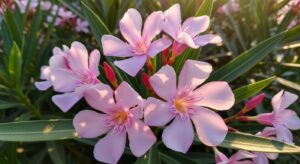
The Lawrence Oleander is renowned for its soft lavender-pink blossoms, which stand out against its deep green foliage.
Unlike many seasonal bloomers, this shrub produces flowers from late spring through early autumn, ensuring months of uninterrupted color in your garden.
Its clustered flowers not only brighten up borders and hedges but also make it a centerpiece plant that radiates charm.
Whether you have a traditional cottage garden, a sleek modern landscape, or a Mediterranean-style courtyard, this plant fits seamlessly into different design aesthetics.
🌞 2. Adaptability in Harsh Conditions

One of the biggest advantages of Lawrence Oleander is its hardiness. Unlike many ornamental shrubs that demand constant care, this variety is highly adaptable.
-
Heat & Sun: It thrives in hot, sunny climates and can withstand prolonged periods of full sun without losing its vigor.
-
Drought: Once established, it requires minimal watering, making it a top choice for xeriscaping and eco-friendly landscaping.
-
Soil Tolerance: From sandy coastal soils to rocky terrains, it adapts remarkably well. Even poor-quality soils don’t stop this shrub from flourishing.
This resilience makes Lawrence Oleander an ideal plant for gardeners living in arid regions or places with water restrictions.
🌿 3. Evergreen Elegance for All Seasons
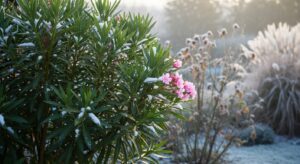
While its flowers steal the spotlight, the evergreen foliage of Lawrence Oleander ensures your garden looks alive and vibrant year-round.
The long, lance-shaped leaves form dense clusters, creating a lush backdrop even when the plant is not in bloom.
This evergreen nature makes it perfect for privacy screens, windbreaks, and structural garden design, keeping your outdoor space visually appealing throughout all seasons.
🏡 4. Perfect for Privacy, Windbreaks, and Noise Reduction

Lawrence Oleander is more than just eye candy—it serves functional landscaping purposes too.
When planted in rows, it forms thick hedges that provide privacy from neighbors, block harsh winds, and even reduce street noise.
For urban homeowners or those with smaller yards, a living wall of oleanders can create a private oasis without the need for fences.
Its dense growth habit also makes it an excellent backdrop for smaller flowers and shrubs, enhancing overall garden structure.
🦋 5. Attracts Pollinators and Enhances Biodiversity
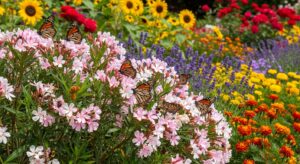
Despite its toxicity to humans and pets, Lawrence Oleander is a favorite for pollinators.
The fragrant blossoms attract bees, butterflies, and even hummingbirds, turning your garden into a buzzing ecosystem.
Planting oleanders alongside other pollinator-friendly flowers like lavender, salvia, or echinacea ensures a continuous nectar supply, supporting local biodiversity.
This not only benefits wildlife but also boosts pollination for fruiting plants in your garden.
💧 6. Water-Wise Gardening and Eco-Friendly Choice
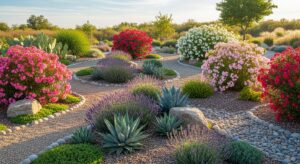
In a world where water conservation is becoming increasingly important, Lawrence Oleander shines as a sustainable option.
With its low water requirements and ability to thrive in arid climates, it’s an excellent plant for drought-prone regions.
Pairing oleanders with gravel paths, succulents, and native drought-resistant plants creates a beautiful Mediterranean-inspired xeriscape garden that saves resources while still looking stunning.
🎨 7. Versatility in Landscaping Design
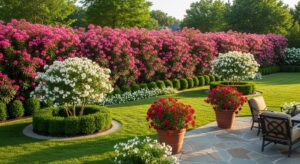
The Lawrence Oleander is incredibly versatile. Depending on your garden’s needs, it can be used as:
-
A Focal Point Shrub: Its vibrant flowers make it a natural centerpiece in any garden.
-
Hedges & Borders: When planted in rows, they create dense hedges for privacy and structure.
-
Container Planting: Smaller specimens thrive in large pots, perfect for patios or balconies.
-
Coastal Gardens: Its tolerance to salt spray makes it suitable for seaside landscapes.
This adaptability allows you to experiment with different design styles, from tropical to contemporary gardens.
✂️ 8. Low Maintenance and Easy Care

Busy gardeners will love how easy it is to care for Lawrence Oleander. Unlike high-maintenance ornamentals, it requires only basic care:
-
Pruning: Once or twice a year to shape and remove dead growth.
-
Watering: Moderate; increase only during extreme heat or drought.
-
Fertilizing: A balanced fertilizer in spring encourages better blooms.
Its resistance to most pests and diseases further reduces the need for chemical treatments, making it a low-maintenance, eco-friendly choice.
⚠️ 9. A Word of Caution: Toxicity
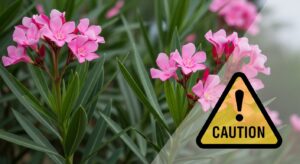
While beautiful, it’s important to acknowledge that all parts of the Lawrence Oleander are toxic if ingested. This includes its leaves, flowers, stems, and even the smoke if burned.
-
Pets & Children: Families with curious pets or toddlers should be cautious when planting oleanders.
-
Garden Safety: Wear gloves while pruning to avoid skin irritation.
Despite this drawback, many gardeners still choose oleanders because their benefits outweigh the risks, especially when planted responsibly in areas away from frequent contact.
🌎 10. Perfect for Mediterranean and Tropical-Inspired Gardens

The Lawrence Oleander brings an exotic flair that pairs beautifully with palm trees, agave, bougainvillea, and lavender. Its long-lasting flowers complement warm-weather gardens, making it a natural choice for:
-
Mediterranean courtyards with terracotta pots and stone pathways.
-
Tropical landscapes with bright flowering companions.
-
Coastal homes are where salt and wind challenge other plants.
By incorporating oleanders into your design, you instantly achieve a resort-like ambiance in your outdoor space.
🪴 11. Container Gardening with Lawrence Oleander
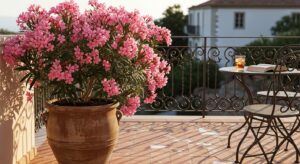
Don’t have a large yard? No problem! Lawrence Oleander grows beautifully in large containers. This makes it an excellent choice for:
-
Apartment balconies
-
Rooftop gardens
-
Small patios
With the right container and regular pruning, it remains compact and manageable while still producing its iconic blossoms.
🌟 12. Long Blooming Season for Maximum Impact
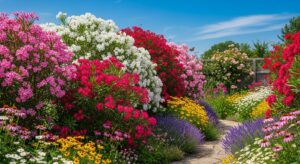
Unlike many shrubs that only bloom for a few weeks, Lawrence Oleander offers months of continuous flowers. From late spring until the first frost, you’ll enjoy waves of lavender-pink blossoms that keep your garden colorful when other plants fade.
This long blooming season makes it an excellent investment for gardeners who want a consistent visual impact throughout the warm months.
🌸 Conclusion: Why Lawrence Oleander Deserves a Place in Your Garden
The Lawrence Oleander is more than just a plant; it’s a statement.
With its evergreen leaves, abundant flowers, resilience in harsh conditions, and landscaping versatility, it delivers beauty and practicality in equal measure.
Whether you want a low-maintenance privacy hedge, a colorful focal point, or a drought-tolerant addition to your yard, this shrub rises to the occasion.
Yes, it requires caution due to its toxicity, but with responsible placement and handling, its benefits far outweigh the risks. Add Lawrence Oleander to your garden, and you’ll gain a stunning, low-maintenance plant that enhances your outdoor space season after season.
❓ 10 FAQs about Lawrence Oleander
1. What makes Lawrence Oleander different from other oleander varieties?
Lawrence Oleander is prized for its lavender-pink blossoms and refined evergreen foliage. While other oleanders also bloom in various colors, Lawrence stands out for its delicate yet vibrant hue and its suitability for ornamental landscaping.
2. Is Lawrence Oleander safe to plant in a family garden?
Oleander, including the Lawrence variety, is toxic if ingested by humans or pets. While safe to enjoy visually, it should be planted in areas where children or animals won’t accidentally consume leaves, flowers, or stems.
3. How tall does Lawrence Oleander grow?
On average, Lawrence Oleander grows 6 to 12 feet tall and can spread up to 10 feet wide. With proper pruning, you can keep it compact or allow it to grow into a dense privacy hedge.
4. Does Lawrence Oleander need a lot of water?
No. One of its best features is drought tolerance. After establishing roots, Lawrence Oleander requires minimal watering, making it perfect for water-wise or xeriscape gardens.
5. What climates are best for growing Lawrence Oleander?
It thrives in Mediterranean, subtropical, and coastal climates where winters are mild and summers are warm. It’s hardy in USDA zones 8–10 but can be grown in containers in cooler regions.
6. How long does Lawrence Oleander bloom?
This shrub offers a long blooming season, often from spring through late fall, ensuring nearly continuous color in the garden.
7. Can Lawrence Oleander be grown in pots?
Yes! It adapts well to container gardening, especially on balconies or patios. Choose a large pot, use well-draining soil, and prune occasionally to maintain shape.
8. How do I prune Lawrence Oleander?
Prune after the flowering season to shape the plant and remove dead branches. Always wear gloves and protective clothing, as the sap is toxic and can irritate the skin.
9. What garden designs work best with Lawrence Oleander?
It’s versatile perfect for hedges, privacy screens, focal points, or Mediterranean-themed gardens. It also blends beautifully with bougainvillea, lavender, and ornamental grasses.
10. Are pests and diseases a problem for Lawrence Oleander?
Generally, Lawrence Oleander is hardy. However, it can be affected by aphids, scale insects, or oleander caterpillars. Regular inspection and organic pest control measures will keep it healthy.